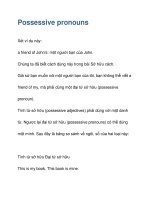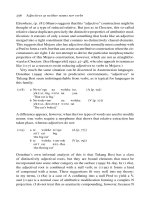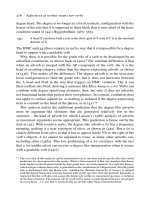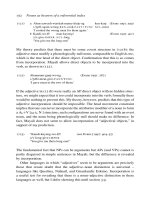Possessive pronouns and adjectives
Bạn đang xem bản rút gọn của tài liệu. Xem và tải ngay bản đầy đủ của tài liệu tại đây (12.38 KB, 1 trang )
Possessive pronouns and adjectives
Possessive adjectives are words like
my, our, your, his, her, their
and
its.
Just like other adjectives, they modify nouns. Examples are given below.
This is
my
car. Which is
your
car?
He takes
his
dog wherever he goes.
She stays with
her
brother’s family.
Possessive pronouns are words like
mine, ours, yours, his, hers
and
theirs
. Possessive pronouns can be used
alone when the meaning is clear.
This is my son. Where is
yours
? (= Where is your son?)
I have handed in my assignment. Have you handed in
yours
? (= Have you handed in your assignment?)
My hair is black.
Yours
is grey.
Possessive pronouns can act as the subject or object of the verb. Possessive adjectives cannot be used like this.
Also they cannot stand alone. They are always followed by a noun.
Possessive nouns
In English, we make possessive nouns in two different ways. The first method is to use
apostrophe + s.
Examples are given below:
John’s
father is an architect.
Mary’s
grandmother is eighty.
We can also make possessive forms by using a structure with of. This method is mainly used when the noun
refers to an inanimate object.
Examples are:
The leg of the table
The colors of the rainbow
The wheels of the car
In very informal English, you will hear expressions like ‘the table’s leg’ and ‘car’s wheels’. However, these
kinds of expressions should be avoided in formal and academic writing.
Be first to know when grammar rules change! Sign up to our newsletter here: englishgrammar.org (It's free)
Powered by TCPDF (www.tcpdf.org)









